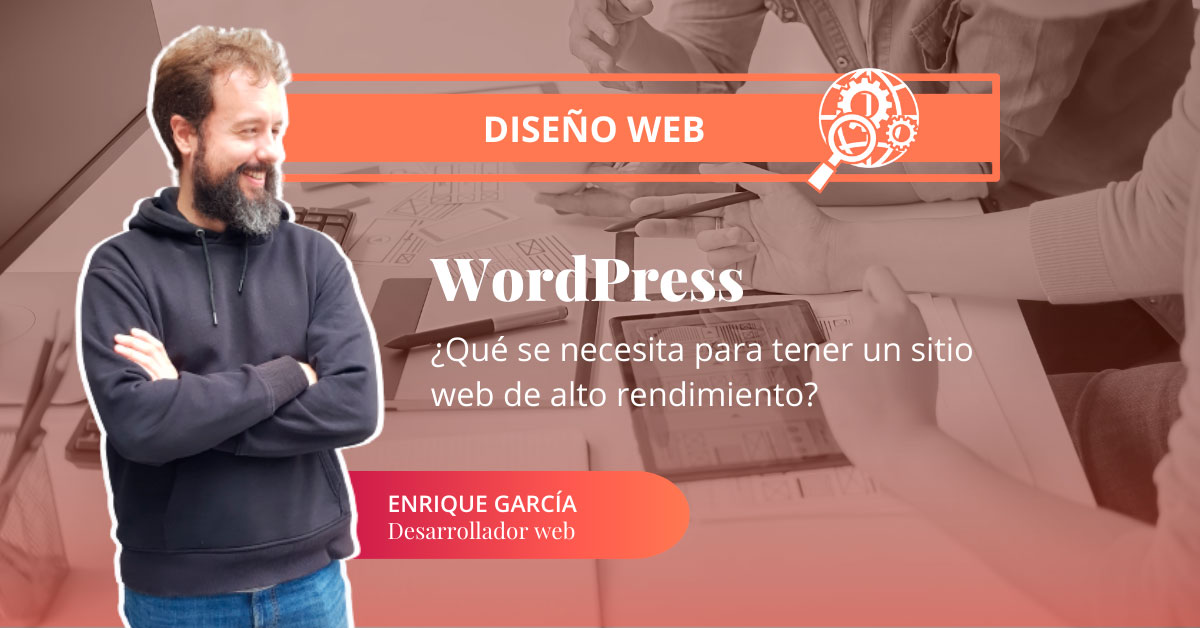To work effectively with WordPress, it is essential to understand the key aspects of web performance optimization (WPO) on this platform. WPO in WordPress involves a set of practices aimed at improving the speed and performance of a website, which in turn impacts user experience and SEO ranking. In this article, we explore the essential strategies and tools for working with WordPress while carrying out effective WPO.
Why is WPO essential in WordPress?
WPO in WordPress, also known as Web Performance Optimization in WordPress, encompasses a set of practices designed to boost the speed and performance of a website built on this platform, including improving Core Web Vitals. It is a fundamental strategy to ensure an optimal user experience and enhance crucial aspects such as SEO ranking, server resource efficiency, and navigation smoothness.
A good WordPress and WPO expert understands that Google, the main search engine, has emphasized loading speed as a determining factor for ranking a website in its results and for meeting Core Web Vitals requirements. Therefore, Web Performance Optimization becomes an essential tool for improving the SEO of a WordPress-hosted site and for meeting Google’s standards.
The process of improving loading speed through WPO in WordPress involves a series of modifications to the website. These optimizations include everything from reducing image sizes to compressing HTML code, all with the goal of improving Core Web Vitals indicators and, in general, offering a faster and more pleasant user experience.
What is WPO about?
Beyond the actions mentioned above, WPO also includes resource optimization, such as JavaScript and CSS files, as well as the implementation of technologies like Content Delivery Networks (CDN) and Gzip compression in WordPress. These measures significantly contribute to reducing the page loading time and ultimately improving user satisfaction.
It is important to highlight that there is a common misconception regarding WordPress being slow by default. However, today approximately 42% of websites on the internet are powered by WordPress as their content management system. The perceived slowness can be related to the amount of data queried in the database and the need to process those requests.
The idea that WordPress may sometimes feel slow is tied to how any content management system based on a database functions. This database is used to constantly store, modify, and retrieve content through requests. Depending on the amount of data and the complexity of these queries, response time can vary, although it is generally expected to be fast. However, when the database is under heavy load, response time can increase, negatively affecting user experience.
This scenario may result in the website taking longer to load and display its content completely, ultimately damaging the user experience.
The good news is that there are effective measures to address this issue and considerably improve the performance of a website built on WordPress. By applying recommended practices and properly implementing WPO strategies in WordPress, it is possible to optimize performance and ensure a smoother, more satisfying user experience.
Measuring WPO in WordPress
If you have a functioning website and worry that WordPress may seem slow, there are online tools that can provide accurate performance data and suggestions for improvement. Here are some of these valuable tools:
Pingdom

Pingdom is a widely used website speed testing tool for evaluating performance. Unlike PageSpeed, it offers a more detailed report that is not limited to Google’s guidelines. It also includes a waterfall analysis feature that is especially useful for diagnosing performance issues.
In addition to analyzing websites, Pingdom offers monitoring services, including uptime monitoring, page speed, transactions, servers, and visitor insights.
GTMetrix
GTMetrix is a website performance analysis tool that helps users conduct a comprehensive evaluation of their website’s performance. It also offers daily monitoring options to track performance over time.

GTMetrix also allows users to change the country and browser from which the website is tested, providing insights into how the site behaves and loads in different contexts.
PageSpeed
PageSpeed is another tool used to measure and optimize a website’s loading speed. Its main objective is to evaluate performance and provide specific recommendations to improve speed.

PageSpeed is based on Google’s guidelines and best practices to ensure that a website meets the required performance standards. By using it, site owners can identify improvement areas such as image optimization, resource compression, and code minimization, offering users a faster browsing experience while also improving ranking in search results.
Choosing the ideal server for WordPress
When hosting a WordPress website, choosing the right server is essential to ensure optimal performance. Here are some key factors to consider when selecting the ideal server:
Performance requirements
Make sure the server offers sufficient resources, such as RAM, storage space, and processing power. These resources should be scalable to adapt to the future needs of your website.
Type of hosting
There are several hosting options, such as free hosting, shared hosting, VPS, cloud hosting, WordPress hosting, and dedicated hosting. Choose the option that best suits your needs.
Security
Security is essential. Ensure that the server has an active firewall and performs regular backups. Additionally, consider implementing extra security measures to protect your website’s information.
Server location:
The geographical location of the server can affect loading speed, especially if your audience is concentrated in a specific region. Choose a location that minimizes loading times for your users.
Support for languages and libraries
Verify that the server supports a variety of programming languages and libraries. For WordPress, it is essential that it supports PHP in different versions. By considering these factors and choosing a server that meets your specific needs, you’ll be on the right track to ensuring optimal performance and a smooth user experience on WordPress.
Smart selection of themes and plugins in WordPress
Optimizing a WordPress website begins in the early stages of the project. After considering server implications, it is crucial to evaluate decisions when installing WordPress and selecting the base theme, along with the plugins that will add functionality to the site.
Theme selection
The WordPress market offers a wide range of themes, both free and premium, tailored to specific projects. However, when choosing a theme, consider these key aspects:
Simplicity: In most cases, less is more. A theme with a basic structure that is not overloaded with unnecessary functions is usually the best option. It is always preferable to use external plugins to add specific functionalities rather than rely on features included in the theme.
Theme Size: Make sure the compressed theme file does not exceed 10 MB. A large theme can negatively affect loading times.
Fonts and Typography: It is recommended that fonts and typography in WordPress be loaded from services like Google Fonts. Loading custom fonts may impact website speed.
Plugin selection
Plugins can significantly affect a WordPress website’s performance. It is important to make smart decisions in this area:
Relevance: Install only the plugins that are essential for the functionalities required on your website. Each plugin consumes server resources such as RAM and processing power. Avoid installing unnecessary plugins.
Updates and Maintenance: Verify that the plugins you choose are updated and maintained regularly by their developers. Outdated plugins can pose security and performance risks.
Performance Evaluation: Use tools like “Query Monitor” to evaluate how plugins affect your site’s performance. This will help you identify and optimize plugins that may be consuming unnecessary resources.
Setting up a CDN in WordPress
A CDN, or Content Delivery Network, is a network of servers located in various geographic locations that store copies of website content to improve loading times for users. Setting up a CDN in WordPress is a relatively simple process:
Choosing the CDN: Start by selecting the right CDN for your needs. There are several options available, each with its features and pricing. Research and choose the one that best fits your website.
Registration and Configuration: Once selected, create an account with the CDN provider. Then configure the CDN on your WordPress site. This usually involves adding a code or configuration provided by the CDN to your website. You can do this manually or through a WordPress plugin.
Making informed decisions when selecting themes and plugins is essential for improving the performance and speed of your WordPress website. These decisions affect not only user experience but also search engine ranking. In addition to these considerations, don’t forget to address other optimization aspects, such as cache management, image optimization, and code reduction, to achieve the best possible performance.



